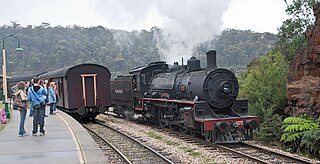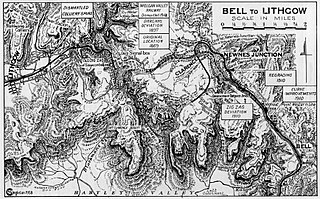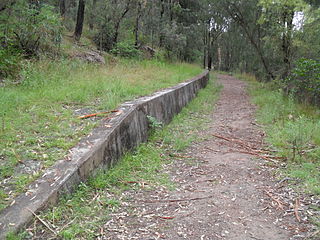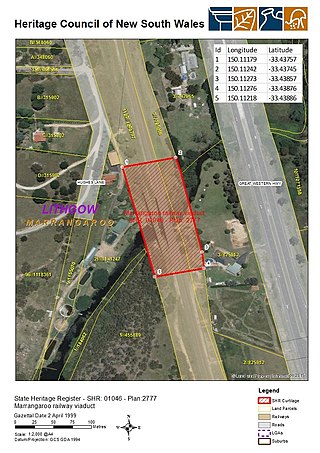
Lithgow is a town in the Central Tablelands of New South Wales, Australia and is the administrative centre of the City of Lithgow local government area. It is located in a mountain valley named Lithgow's Valley by John Oxley in honour of William Lithgow, the first Auditor-General of New South Wales.

A railway zig zag or switchback is a railway operation in which a train is required to switch its direction of travel in order to continue its journey. While this may be required purely from an operations standpoint, it is also ideal for climbing steep gradients with minimal need for tunnels and heavy earthworks. For a short distance, the direction of travel is reversed, before the original direction is resumed. Some switchbacks do not come in pairs, and the train may then need to travel backwards for a considerable distance.

The Zig Zag Railway is an Australian heritage railway, situated near Lithgow, New South Wales. It was opened by the not-for-profit Zig Zag Railway Co-op as an unpaid volunteer-staffed heritage railway in October 1975, using the alignment of the Lithgow Zig Zag line that formed part of the Main Western line between 1869 and 1910. The line climbs the western flank of the Blue Mountains, using railway zig zags to gain height.

The Kalamunda Zig Zag was a zig zag rail line that was part of the Upper Darling Range Railway line in Western Australia, opening in July 1891 and closing in July 1949. Most of it was converted to a public road in 1952, part of which is now a tourist drive called Zig Zag Scenic Drive that offers views of Perth from the hills.

The Lapstone Zig Zag was a zig zag railway built between Emu Plains and Blaxland stations on the Main Western Line of New South Wales in Australia. Constructed between 1863 and 1865 to overcome an otherwise insurmountable climb up the eastern side of the Blue Mountains, the zig zag and associated Knapsack Viaduct, a sandstone arch viaduct, were designed by John Whitton, Engineer-in-Charge of New South Wales Government Railways, and were built by William Watkins. The zig zag was listed on the Blue Mountains local government heritage register on 27 December 1991; while the adjacent Knapsack Viaduct was listed on the New South Wales Heritage Database on 2 April 1999. The Lapstone Zig Zag was the world-first Zig Zag constructed on any main-line railway.

Zig Zag railway station is located on the New South Wales Main Western Line. It was originally built in April 1878 and closed in 1910 due to the opening of the Ten Tunnels Deviation which bypassed the original site of the station. The station was not rebuilt until 1959 when a new station was built alongside the 1910 alignment in a similar location to the 1878 station.

Lithgow railway station is a heritage-listed former station master's residence and railway station located on the Main Western line at Railway Parade, Lithgow, City of Lithgow, New South Wales, Australia. It was designed and built by New South Wales Government Railways and built from 1924 to 1925. It is also known as Lithgow Railway Station Group and Residence and Eskbank East. The property was added to the New South Wales State Heritage Register on 30 August 2013. The station has frequent NSW TrainLink services running to and from Sydney Central.

The Midland Junction railway station was an important junction station on the Eastern Railway of Western Australia until its closure in 1966.

The City of Lithgow is a local government area in the Central West region of New South Wales, Australia. The area is located adjacent to the Great Western Highway and the Main Western railway line.

The Newnes Junction railway station is a closed railway station on the Blue Mountains Line, New South Wales, Australia. It served the former private branch line to Newnes. The station closed to passenger services in 1975, although it still physically exists and is occasionally used for coal trains visiting the nearby Clarence Colliery. The station consists of an island 'Up' platform, and a single side 'Down' platform.
Cooerwull railway station was a railway station on the Main Western railway line in New South Wales, Australia.

The Lithgow Zig Zag is a heritage-listed former zig zag railway line built near Lithgow on the Great Western Line of New South Wales in Australia. The zig zag line operated between 1869 and 1910, to overcome an otherwise insurmountable climb and descent on the western side of the Blue Mountains. It was designed by John Whitton and built from 1863 to 1869 by Patrick Higgins as contractor. It is also known as the Great Zig Zag Railway and Reserves and Zig Zag Railway. The property is owned by Department of Planning and Infrastructure. It was added to the New South Wales State Heritage Register on 2 April 1999.

The Ten Tunnels Deviation is a heritage-listed 9.2-kilometre (5.7 mi) section of the Main Western Line between Newnes Junction and Zig Zag stations in Lithgow, New South Wales, Australia. It was designed and built by the New South Wales Government Railways and built from 1 June 1908 and 16 October 1910. It is also known as Great Zig Zag Railway deviation tunnels and Bell to Zig Zag Ten Tunnel Railway Deviation. It was added to the New South Wales State Heritage Register on 2 April 1999.
The Glenbrook deviation was a section of track on the Main Western line from the first Knapsack Viaduct to old Glenbrook station in the Blue Mountains of New South Wales, Australia. The approximately five-mile-long (eight-kilometre) deviation was constructed from 1891 to 1892 and replaced the Lapstone Zig Zag. The deviation was closed in 1913 when it was replaced by the second Glenbrook deviation and the second Glenbrook Tunnel, that continues to carry the Main Western line today.

Shakespeare Cliff Halt is a private halt station on the South Eastern Main Line. It is located to the western end of the dual-bore Shakespeare Cliff tunnel on the South Eastern Main Line to Folkestone, England. It never appeared in any public timetable and has been used successively by railway staff, coal miners, the military and Channel Tunnel workers.

The Lucasville railway station is a decommissioned railway station on the Lapstone Zig Zag that closed in 1892.

Flieden station is a station in the town of Flieden in the German state of Hesse, where the Flieden–Gemünden railway branches off the Frankfurt–Göttingen railway. The station is classified by Deutsche Bahn (DB) as a category 5 station.

Bottom Points is a railway station on the Zig Zag Railway in the Blue Mountains area of New South Wales.

The Marrangaroo railway viaduct is a heritage-listed railway viaduct that carries the Main Western Line across Marrangaroo Creek at Marrangaroo in the City of Lithgow local government area of New South Wales, Australia. The property added to the New South Wales State Heritage Register on 2 April 1999.

The Cooerwull railway footbridge is a heritage-listed pedestrian bridge located at Top Points Station, Zig Zag Railway, Lithgow, City of Lithgow, New South Wales, Australia. It was built in 1941. It was added to the New South Wales State Heritage Register on 2 April 1999.


















